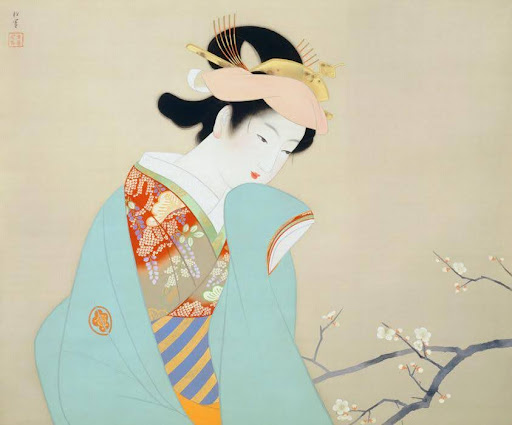9.春芳(Shunpō)
内面の感情や季節の移ろいを繊細に表現した作品

《春芳(しゅんぽう)》は、1940年に描いた作品、勝山髷を結った若い女性が、袖を口元に添えながら梅の花に目を向けている。春の香りに心が動いている様子が繊細に表現されている。外側は白緑(びゃくろく)の打掛、内側は赤い鹿の子絞りの着物。帯には「小六縞(ころくじま)」という斜め縞模様が使われ、歌舞伎役者・嵐小六に由来する柄である。鴎髱(かもめづと)と呼ばれる髪型は後頭部が反り返るように描かれている。眉はスッと流れるような山型で、松園が「最も難しい」と語った部分。生え際の毛描きも浮世絵の技法を応用し、一本一本丁寧に描かれている。半襟や肌、鹿の子絞りの粒など、複数の白を使い分けて立体感と気品を演出。松園の美人画の中でも特に色彩・構図・技法が凝縮された一作であり、彼女の「気品ある女性像」へのこだわりが細部にまで宿っている作品である。
Shunpō (Fragrance of Spring)
A delicate portrayal of inner emotion and seasonal transition
Painted in 1940, Shunpō depicts a young woman, with a katsuyama-mage, with her sleeve gently raised to her lips, gazing at blooming plum blossoms. Her subtle gesture conveys a quiet emotional response to the fragrance of spring. She wears a pale green uchikake (outer robe) over a red kanoko shibori kimono, and her sash features the diagonal Koroku-jima stripe pattern, named after the Kabuki actor Arashi Koroku.
Her hairstyle, known as kamome-zuto, curves elegantly at the back of her head, while her eyebrows form a soft mountain-like arc—a detail Uemura once described as “the most difficult to paint.” The hairline is drawn with precision, using techniques inspired by ukiyo-e to depict each strand with care.
Multiple shades of white are used to differentiate the han-eri (collar), skin tones, and the textured dots of the shibori, creating a sense of depth and refinement. Among Uemura’s bijin-ga, this work stands out for its masterful use of color, composition, and technique, embodying her commitment to portraying women with grace and dignity.
お問い合わせ
〒154-0024 東京都世田谷区三軒茶屋1-39-7